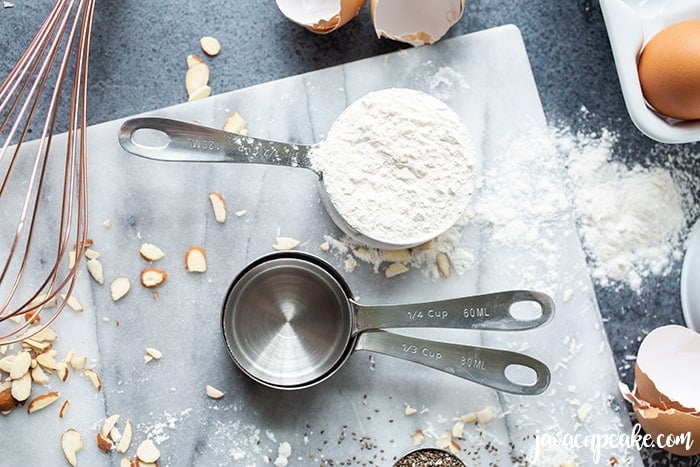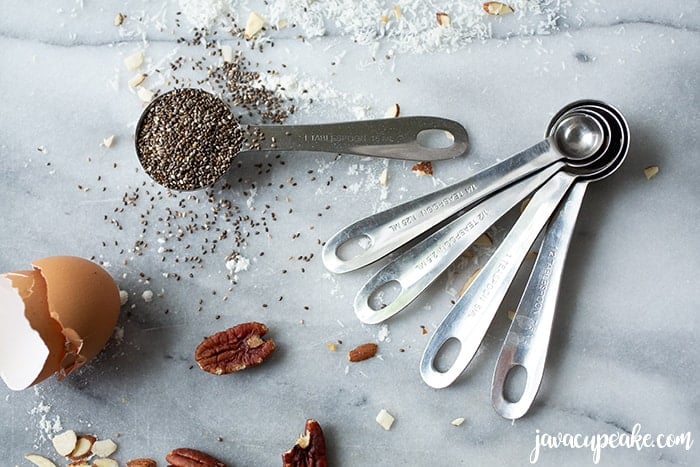Ever found yourself in the middle of a baking spree, only to realize you’re not sure how many grams of flour make a cup? Or perhaps you’ve stumbled upon a delightful European recipe but got stumped by the metric measurements? Fret not! Our ultimate Baking Conversion Charts are here to save the day (and your cake)!

Why Baking Measurements Matter 📏
Baking isn’t just an art; it’s a science! A pinch too much or a tad too little can turn your soft-baked cookies into, well, cookie rocks. That’s why precision is key.
With our baking conversion charts, you’ll nail the measurements every time, ensuring fluffy cakes, perfect pies, and cookies that are just right.
Imperial vs. Metric: The Great Debate 🌍
- Imperial System: Mostly used in the United States. Think inches, feet, and pounds.
- Metric System: The favorite of many countries worldwide. It’s all about meters, grams, and liters. And guess what? It’s based on the number 10, making conversions a breeze!

Tips and Tricks for Precision and Perfection 🌟
Baking is indeed an exhilarating adventure, and like any great explorer, you need a map and compass. In baking, our “map” is the recipe, and our “compass” is the precision in measuring ingredients.
Here’s how you can use our Baking Conversion Charts effectively, along with some tips to avoid common measurement mishaps.

- Measuring Flour:
Flour can be a fickle friend. For accuracy, spoon the flour into your measuring cup and level it off with a knife. This technique prevents the flour from being overly compacted, which is a common issue when scooping directly from the bag. Our conversion charts can help you accurately convert cup measurements to grams or ounces, ensuring you’re using just the right amount every time. - Room Temperature Ingredients:
Ingredients like butter, eggs, and dairy blend more smoothly when at room temperature. But how do you measure butter straight from the fridge? Use our charts to convert butter measurements from cups to grams or tablespoons. This way, you can cut the exact amount you need and let it warm up while you prep other ingredients. - Sugar Subtleties:
Different sugar types can dramatically affect your baking. For instance, granulated sugar and powdered sugar have distinct volumes and weights. Use our charts to convert these measurements accurately. Remember, packing brown sugar into a cup can increase its weight, affecting the sweetness and texture of your bake. - Liquids and the Art of Precision:
Liquid ingredients can be tricky. Our charts come in handy for converting fluid ounces to milliliters, ensuring you add just the right amount of milk, water, or oil. A kitchen scale can be your best friend here for precise liquid measurements.
Common Baking Blunders and How to Dodge Them Using Conversion Charts 🛑
Even seasoned bakers can slip up, especially when it comes to measurements. Here are some pitfalls to avoid, with a little help from our charts.

- Overmixing Dough:
It’s easy to overdo it with the mixer. To prevent this, measure your ingredients accurately using our charts. This ensures you’re starting with the right ratios, reducing the temptation to overmix. - Ignoring Oven Preheating:
The right oven temperature is crucial. Use our temperature conversion chart to switch between Celsius and Fahrenheit effortlessly, ensuring your oven is perfectly preheated according to the recipe’s demands. - Misjudging Baking Powder and Soda:
Even a slight misstep with leavening agents can lead to flat or overly risen bakes. Our charts help you convert teaspoons to grams, ensuring you’re adding just the right amount. - Salt: The Flavor Enhancer:
Too little or too much salt can dramatically alter your baked goods’ flavor profile. If your recipe calls for kosher salt and you only have table salt (or vice versa), use our conversion charts to adjust the measurements accordingly.

By integrating these tips and tricks with the use of our Baking Conversion Charts, you’re setting yourself up for success in the kitchen.
Remember, baking is as much about the journey as it is about the delicious destination. Happy baking! 🎂📏
Your Baking Conversion Charts Lifesavers 🦸♀️
- Basic Ingredients Conversion Chart: From flour to sugar, butter, and even heavy cream, we’ve got you covered. Download & Print Here

- Measurements & Temperatures Chart: Liquids, nuts, baking chips, and even a Celsius to Fahrenheit conversion for those tricky oven settings. Grab Yours Now

- Mini Printable Temperature Chart: A handy little chart to stick right by your oven. Never second-guess those temperatures again! Download & Stick

A Sweet Note 🍪
Baking is all about spreading joy, one treat at a time. With these charts, we hope to sprinkle a bit of that joy into your baking adventures.
Happy baking, and may your treats always rise to the occasion!
Downloadable Resources:
- 📌 Basic Ingredients Conversion Chart
- 📌 Measurements & Temperatures Chart
- 📌 Mini Printable Temperature Chart
Share your baking successes (or hilarious fails) with us in the comments below!
And if you found these baking conversion charts helpful, don’t forget to share them with your fellow baking buddies. 🍰
Awesome! I have some Swedish cookbooks and recipes and they are all in metric! Pinning these for later so I don’t forget! Thanks for posting them! It’s gonna save me so much time rather than converting everything myself lol.
I have a few German cookbooks… now if there was only a chart that translated recipes from German to English! haha 🙂 Happy Baking, Kara!
I’m always looking for these conversion! Now I have it right at my finger tips!
These are so adorable! Love it!
these are SO fun | I can;t wait to hang them in my kitchen
Yay! Glad you like them!
I needed this! Thanks!
These are awesome! 🙂
We sometimes get asked on our blog for ingredient conversions – I’m going to send them here. This is great!
Oh thanks, Martha! So glad this can be helpful to your readers!! xoxo
THANK YOU!! I have avoided some recipes because I would have to convert…Now I can print and frame it! Awesome!
I’ve been in the exact same situation. Now I have a cute go-to chart that I can keep on my fridge for easy access to the conversions! Happy Baking!
Very helpful, Betsy. But please note that “Celsius” is misspelled as “Celcius” on a couple of your charts 🙂
Jah
I totally missed that error! Thanks for pointing it out to me…. I’ll have my designer fix it ASAP! 🙂
Thank you so much these are adorable.
You are so welcome! I’m glad you enjoy them!
These are great! Thanks so much!
Thanks for these adorable charts! I was looking for something I could post up in the kitchen and this is SUPER cute. I grew up in California but have been in Melbourne for several years now and I can never remember Imperial equivalents to Metric!
You’re welcome Christina! I’m so glad you love them as much as I do!
Thank you so much for sharing the conversion table!☺
God bless your generous heart!♥
Thanks for this cute conversion chart. I also live in Bavaria, not Graf though. I finally decided to print out something handy that I could tape to the inside of my cabinet next to my stove and this is perfect. Thank you!
So glad you love it as much as I do!! Happy Baking 🙂
super
my packages of flour indicate that 120 grams is 1 cup and confectioners sugar 1 cup=120 grams.
Thank you so much for coming up with these charts. They are so useful that I have a copy of these on my fridge for my weekly baking sessions! Also because they make the lives of homemakers so much easier, I would love to share this with my readers on my blog. Hence, I have included your charts in my blog (of course, with all credits and a link back to you and your team at The JavaCupcake Blog). Thank you so much for this useful chart. Cheers!
Thanks a lot.
I love this. People typically measure 1 cup of flour anywhere between 4-6 ounces…(contents may have settles, it may be unsifted or sifted, and people just ‘scoop’ differently.) I use only weight measures for baking now and my results are crazy super consistent. Thanks for the metric chart (I just use my scale and clean only 1 measuring device) YAY!
Hey really yummy recipes. I love cupcakes, please guide me soft cupcakes recipe.
I NEED HELP! I HAVE A RECIPE THAT CALLS FOR 5g BAKING POWDER, 2g CINNAMON, AND 3g SALT. CAN YOU HELP ME BY CONVERTING THESE MEASUREMENTS TO TEASPOONS AND TABLESPOONS PLEASE?
That’s what the charts are for, friend 🙂
So adorable. Just what I needed for my move out of the country. I plan to laminate and keep handy as I learn to live in a metric world.
Fabulous!
They looked soooo good, I had to try and make them. I used your suggestion and used 1/2 cup flour. Thx for sharing Betsy!
Thanks for baking conversion charts! I’m also gonna pin this post on my Pinterest board my followers will love it. Thanks Betsy!
Ola
Good share.
I think the great cccam are those from Fishbone cccam
I would like to see more posts like this
Thanks
THAAAANK YOUUUUU!!!
your charts are AWESOME!!!!!
conversion charts baking looks so good this looking so beautiful .thanks for this post
conversion charts very healthy and delicious.thanks for sharing helpful post.
I visited your blog for the first time and just been your fan. I Will be back often to check up on new stuff you post!
thanks for this sharing useful post.
these charts are very helpful for students too.as i am student of hotel management i need this chart eveytime during my exams.
thankyou.
Thank you so much for these great charts & they are so cute to boot!!!